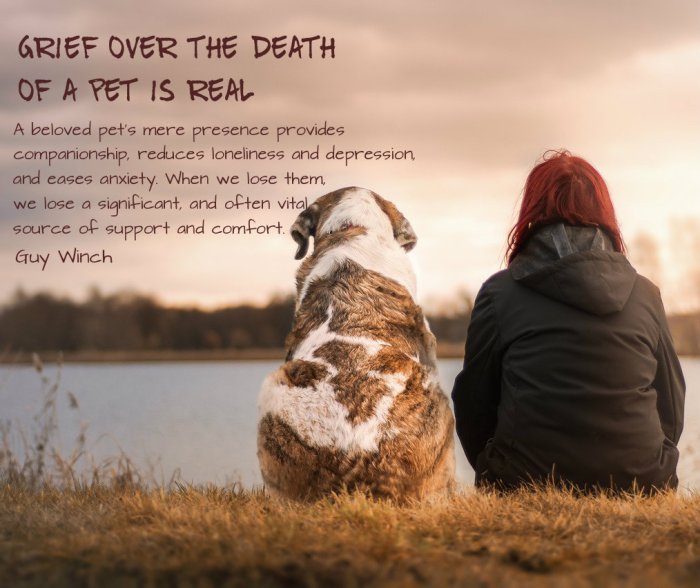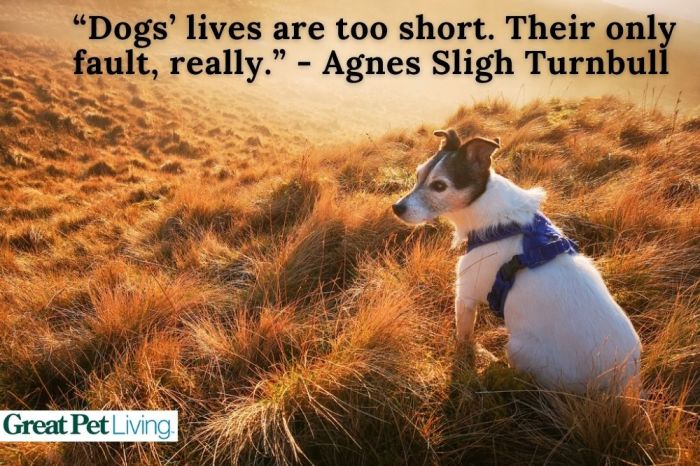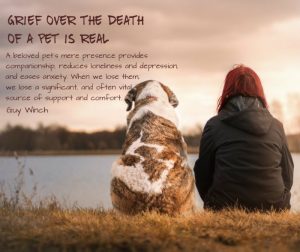
Grieving the death of a pet is a deeply personal experience, often underestimated in its intensity. The unique bond we share with our animal companions transcends simple companionship; it’s a relationship built on unconditional love, trust, and shared experiences. This profound connection makes the loss of a pet particularly painful, triggering a grieving process that mirrors, yet uniquely differs from, human bereavement.
Understanding the stages of grief, practical considerations, and available support systems is crucial in navigating this challenging time.
This guide explores the emotional, practical, and spiritual aspects of pet loss, offering insights and resources to help you through your journey. We will examine the stages of grief, practical steps for handling your pet’s passing, ways to honor their memory, and the importance of seeking support during this difficult period. We will also explore broader perspectives on death and dying, comparing the experience of losing a pet to losing a human loved one, and considering cultural and spiritual influences on the grieving process.
The Emotional Impact of Pet Loss
The death of a beloved pet is a profoundly significant loss, often triggering a complex and intense grieving process. While the experience is deeply personal, many parallels exist between pet bereavement and human grief, although societal norms often minimize the intensity of the former. Understanding the emotional impact of pet loss is crucial for supporting those who experience it.The Stages of Grief in Pet LossThe stages of grief, though not always linear, are frequently experienced in a similar manner to human bereavement.
Individuals may experience denial, where the reality of the pet’s death is initially rejected; anger, directed at oneself, others, or even fate; bargaining, attempting to negotiate with a higher power or fate for a different outcome; depression, characterized by sadness, withdrawal, and despair; and finally, acceptance, a gradual process of coming to terms with the loss. The duration and intensity of each stage vary greatly depending on the individual, the nature of the pet-owner bond, and the circumstances of the pet’s death.
For example, a sudden and unexpected death may lead to more pronounced feelings of shock and denial, while a prolonged illness might allow for more anticipatory grieving.Unique Aspects of Grieving a PetThe bond between a person and their pet is often incredibly strong, characterized by unconditional love, companionship, and shared experiences. This deep connection can lead to an intensity of grief that is sometimes underestimated or dismissed by those who haven’t shared such a relationship.
Society often undervalues the significance of pet loss, leading to feelings of isolation and invalidation for grieving pet owners. The lack of readily available social support systems specifically designed for pet bereavement can exacerbate these feelings. Unlike human bereavement, where societal rituals and expectations are well-established, the grieving process for pet loss often lacks formal recognition, further contributing to the feeling of isolation.Guilt and Responsibility in Pet LossFeelings of guilt and responsibility are common in pet bereavement.
Owners may question their actions leading up to their pet’s death, wondering if they could have done something differently to prevent it. This is particularly true in cases of illness where treatment decisions were involved or if an accident occurred that the owner feels they could have avoided. These feelings of guilt can be amplified by societal expectations regarding pet care and responsibility.
The perceived failure to adequately care for or protect the pet can intensify the emotional pain associated with loss. For example, a pet owner who feels they could have sought veterinary attention sooner may experience profound guilt and self-blame.Coping Mechanisms for Pet LossCoping with the loss of a pet requires patience, self-compassion, and support. Many find solace in talking to friends, family, or support groups specifically designed for pet loss.
Memorializing the pet through photos, keepsakes, or a memorial service can provide a sense of closure and allow for the expression of grief. Engaging in activities that bring comfort, such as spending time in nature, listening to music, or practicing mindfulness, can help manage emotional distress. Seeking professional support from a therapist or counselor can also be beneficial, especially if grief is significantly impacting daily life.
Journaling about the pet and the experience of loss can be a powerful way to process emotions and find meaning in the relationship.
Practicalities of Pet Death: Grieving The Death Of A Pet
Losing a beloved pet is incredibly difficult, but navigating the practicalities following their death can add to the emotional burden. Understanding the steps involved, the associated costs, and available resources can help ease this process and allow you to focus on grieving. This section Artikels the practical aspects of pet loss, offering guidance and support during this challenging time.
Disposal of Remains
Several options exist for handling your pet’s remains, each with its own considerations. Burial is a common choice, allowing for a private and personal farewell. However, it’s crucial to check local regulations regarding pet burial on private property; some areas have restrictions. Cremation offers another alternative, providing the option of keeping your pet’s ashes in an urn or scattering them in a meaningful location.
Group cremation, often more affordable, involves cremating multiple pets together. Veterinarians or pet funeral homes can provide guidance on the different options and arrange the services.
Financial Implications of Pet Loss
Unexpected veterinary bills in the final stages of a pet’s life can be significant. Costs can vary widely depending on the pet’s condition, the type of treatment received, and the location. Beyond veterinary expenses, consider the costs associated with cremation or burial services, memorial items such as urns or headstones, and potentially transportation fees. Pet insurance can help alleviate some of these financial burdens, though coverage varies between policies.
It is advisable to explore options like payment plans with veterinary clinics or crowdfunding platforms for financial assistance. For example, a recent study showed average cremation costs ranged from $150 to $500, while burial costs could be substantially higher depending on the chosen method.
Resources for Pet Owners
Coping with pet loss is a deeply personal journey, and many resources exist to provide support and guidance. Support groups, both online and in-person, offer a safe space to share experiences and connect with others who understand the unique pain of pet loss. Many veterinary clinics and animal shelters offer bereavement resources or can connect pet owners with support networks.
Online communities and forums dedicated to pet loss can provide comfort and practical advice. Grief counseling specifically tailored to pet loss can also be incredibly beneficial. The ASPCA and other animal welfare organizations often provide helpful information and links to support networks.
Checklist for Managing the Immediate Aftermath
Planning ahead can ease the immediate aftermath of your pet’s passing. This checklist provides a framework to manage practical tasks while allowing for emotional processing.
- Contact your veterinarian to discuss options for pet remains disposal and any necessary paperwork.
- Gather important documents such as microchip information and vaccination records.
- Choose a method for disposal (burial, cremation) and arrange the necessary services.
- If opting for cremation, decide whether to keep the ashes or scatter them.
- Consider creating a memorial for your pet, such as a photo album or planting a tree.
- Reach out to support groups or online communities for emotional support.
- Inform close friends and family of your pet’s passing.
- Review pet insurance documents to understand coverage and reimbursement processes for final veterinary bills.
Remembering and Honoring Your Pet

Saying goodbye to a beloved pet is incredibly difficult, but cherishing their memory can offer comfort and solace during the grieving process. Finding ways to honor their life and legacy allows you to keep their spirit alive, transforming your sadness into a celebration of the joy they brought into your life. This section explores various methods for memorializing your pet, considering both the emotional and practical aspects involved.
Memorialization Options for Beloved Pets
Choosing how to remember your pet is a deeply personal decision. The best approach will depend on your budget, personal preferences, and the bond you shared. Consider these options, each offering a unique way to keep your pet’s memory alive.
| Method | Description | Cost | Emotional Impact |
|---|---|---|---|
| Photo Album or Scrapbook | Compile cherished photos and mementos, adding handwritten captions and anecdotes to create a lasting visual record of your pet’s life. Consider including veterinary records, adoption papers, or favorite toys. | Low to Moderate (depending on the album’s quality and embellishments) | Highly personal and deeply sentimental; allows for reflection on specific memories and milestones. |
| Memorial Garden or Planting a Tree | Plant a tree, flowers, or create a small garden dedicated to your pet. This offers a living tribute that grows and changes over time, much like your memories of them. Choose plants that were your pet’s favorites or that symbolize qualities you admired in them. | Low to Moderate (depending on the scale and plants chosen) | Provides a tangible connection to your pet, offering a peaceful space for reflection and remembrance. |
| Donation to an Animal Shelter or Rescue | Donate to an animal shelter or rescue organization in your pet’s name. This honors their memory while supporting other animals in need. Many organizations offer certificates or acknowledgment of your donation. | Variable, depending on the amount donated. | Provides a sense of purpose and continues the legacy of caring for animals. |
| Commissioned Artwork or Portrait | A painted portrait, sculpture, or other artistic representation of your pet can capture their unique personality and likeness. This can be a lasting and cherished piece of art within your home. | Moderate to High (depending on the artist and complexity) | Creates a beautiful and enduring reminder of your pet’s physical appearance and essence. |
| Urn or Keepsake | If you chose cremation, consider an urn or keepsake to hold your pet’s ashes. These come in various styles and materials, allowing you to choose one that reflects your pet’s personality. | Low to High (depending on material and design) | Provides a tangible way to keep your pet close, offering a sense of comfort and closure. |
| Memorial Jewelry | Necklaces, bracelets, or other jewelry containing a small amount of your pet’s ashes or a lock of fur provides a constant, subtle reminder of your pet. | Moderate | Keeps your pet close to your heart in a discreet and personal way. |
Creative Ways to Keep a Pet’s Memory Alive
Beyond traditional methods, many creative options exist to keep your pet’s memory alive. Consider compiling a collection of their favorite toys, creating a slideshow of photos set to their favorite music, or writing a heartfelt letter detailing your favorite memories together. These personal touches can significantly enhance the grieving process and provide lasting comfort.
Seeking Support During Grief
Losing a beloved pet is a deeply personal experience, often accompanied by intense grief that can feel overwhelming. It’s crucial to remember that you are not alone in this, and seeking support from others is a sign of strength, not weakness. Allowing yourself to grieve openly and honestly is a vital part of the healing process.The intensity and duration of grief after pet loss varies greatly from person to person.
While some may experience a relatively short period of sadness, others may grapple with more prolonged and complex emotions. Understanding the signs of complicated grief and knowing when to seek professional help is essential for navigating this challenging time.
Signs of Prolonged or Complicated Grief and the Need for Professional Help
Prolonged or complicated grief following pet loss can manifest in several ways. These may include persistent and debilitating sadness, an inability to function normally in daily life, intense feelings of guilt or self-blame, and difficulty accepting the pet’s death. If these feelings persist for an extended period (typically beyond six months) and significantly impact your daily life, seeking professional help from a therapist or counselor specializing in pet loss is strongly recommended.
They can provide a safe and supportive space to process your emotions and develop healthy coping mechanisms. A professional can also help differentiate between normal grief and complicated grief, ensuring you receive the appropriate support.
Benefits of Support Groups and Therapy
Joining a pet loss support group offers a unique opportunity to connect with others who understand the profound impact of losing a cherished companion. Sharing experiences and hearing from others who have navigated similar grief can be incredibly validating and comforting. The shared understanding and empathy within a support group create a powerful sense of community and can significantly alleviate feelings of isolation.
Similarly, talking to a therapist provides a confidential space to explore your emotions, identify triggers, and develop strategies for managing grief effectively. Therapy can equip you with tools and techniques for coping with difficult emotions, improving your overall well-being and fostering resilience.
Illustrative Anecdotes, Grieving the death of a pet
Sarah, a young woman who recently lost her elderly cat, initially felt isolated in her grief. Friends and family offered sympathy, but she felt they couldn’t fully grasp the depth of her connection with her cat. Joining an online pet loss support group allowed her to share her experiences without judgment and discover she wasn’t alone in her sorrow.
Connecting with others who understood the unique bond between humans and animals helped Sarah find solace and begin her healing journey. Another example is Mark, whose dog passed unexpectedly. Overwhelmed by guilt and sadness, he found himself unable to function at work or at home. Therapy provided him with the tools to process his grief healthily, helping him navigate his emotions and develop coping strategies to manage his daily life.
Death and Dying
The death of a pet, while profoundly painful, offers a unique opportunity to confront the universal experience of mortality. Understanding death and dying, both in the context of our animal companions and ourselves, can provide a framework for navigating grief and finding meaning in loss. The similarities and differences between human and animal death, alongside cultural and spiritual perspectives, illuminate the multifaceted nature of this process.Death and dying are biological processes, marked by the cessation of vital functions.
For both humans and pets, this process can be gradual or sudden, peaceful or traumatic. However, the human experience is often imbued with a greater sense of awareness and anticipation, while pets typically experience death with less cognitive understanding of its finality. The emotional response, however, transcends species; the profound bond we share with our pets results in a grief that mirrors, in many ways, the sorrow of losing a human loved one.
Cultural Perspectives on Pet Death
Cultural norms significantly shape how we grieve the loss of a pet. In some cultures, pets are viewed as working animals or property, leading to less elaborate mourning rituals. Other cultures integrate pets fully into the family structure, resulting in ceremonies and memorials similar to those for human family members. For example, in some parts of Asia, pet funerals are common, involving elaborate rituals and the creation of small gravesites.
In contrast, Western cultures often emphasize private mourning, with memorials ranging from simple burials to personalized memorial services. These differences highlight the wide spectrum of human responses to pet loss, influenced by societal values and beliefs.
Spirituality and Belief Systems in Coping with Pet Loss
Spirituality and religious beliefs play a significant role in how individuals cope with pet loss. For some, the belief in an afterlife provides comfort, envisioning a reunion with their beloved pet in a spiritual realm. Others find solace in the idea of reincarnation, believing their pet’s spirit will be reborn. These beliefs can offer a sense of continuity and hope, mitigating the pain of separation.
Even without formal religious beliefs, many find comfort in personal spiritual practices, such as meditation or connecting with nature, to process their grief and find meaning in their pet’s life and death.
Comparing Pet Loss and Human Loss
The experience of losing a pet shares many similarities with the loss of a human loved one, yet there are also crucial distinctions.
The following points compare and contrast these experiences:
- Intensity of Grief: While the intensity of grief varies greatly depending on individual circumstances, the bond with a pet can evoke profound sadness, mirroring the depth of grief experienced after the loss of a human.
- Social Validation: Societal norms often offer greater validation for grief following the loss of a human, while grief over a pet can sometimes be minimized or dismissed. This lack of social acknowledgment can make the grieving process more isolating.
- Length of Grief: The duration of grief is subjective and influenced by many factors. While grief for a human may be prolonged due to complex relationships and life events, the grieving process for a pet can also be extensive and deeply impactful.
- Nature of the Relationship: Human relationships are complex and multifaceted, involving shared history, communication, and social interactions. Pet relationships, while less complex, often offer unconditional love and companionship that can be just as significant.
- Practicalities: The practicalities of dealing with death differ significantly. The legal and financial implications of human death are far more extensive than those related to pet death.
Illustrative Examples

Experiencing the death of a beloved pet is profoundly personal. The following examples aim to illustrate the diverse ways grief manifests and the various methods people employ to find comfort and remembrance. These are fictional accounts, but they reflect the common emotional and practical experiences of pet loss.
A Fictional Pet’s Death and Subsequent Grieving
Old Man Willow, a ginger tabby cat, had been a constant companion to Eleanor for fifteen years. His purr, a low rumble like distant thunder, was the soundtrack to her evenings. The day he died, a quiet Tuesday, was marked by an unusual stillness in the house. Eleanor found him curled in his favorite sunbeam, his breath shallow, a faint tremor in his whiskers.
The air hung heavy with the scent of his fur, a familiar comfort now tinged with the sharp, metallic tang of death. The silence that followed was deafening, broken only by the occasional, choked sob. The next few weeks were a blur of numb routine punctuated by waves of intense sadness. She found herself constantly reaching for him, her hand instinctively going to the empty space beside her on the sofa.
Sleep offered little respite, filled with vivid dreams of him chasing butterflies in a sun-drenched meadow. The vibrant colors of his fur seemed to fade from memory, replaced by a lingering ache in her heart. The once comforting scent of his fur now evoked a fresh pang of loss. Even the sound of rain against the windowpanes, once a soothing melody, now felt like a constant reminder of his absence.
Visual Elements of a Pet Memorial Service
The memorial service for Pip, a beloved golden retriever, was held in a sunlit garden. Soft, acoustic guitar music played gently in the background, creating a calm and peaceful atmosphere. A large photograph of Pip, his tail wagging joyfully, was placed on a simple wooden easel. Surrounding the photograph were numerous smaller pictures, each capturing a different aspect of his playful, affectionate personality.
A collection of Pip’s favorite toys – a well-loved squeaky tennis ball, a ragged plush toy – were arranged neatly on a nearby table. Guests were invited to share their memories of Pip, their voices filled with both laughter and tears. The overall tone was one of celebration of his life, a tender acknowledgment of his impact on those who loved him.
The warm sunlight filtering through the leaves created a dappled effect on the ground, casting gentle shadows that seemed to dance along with the happy memories shared.
Description of a Pet Memorial Garden
Esmeralda’s memorial garden for her beloved parrot, Coco, was a vibrant explosion of color and texture. A small, ornate bird bath sat in the center, surrounded by bright, flowering plants – sunflowers, Coco’s favorite, were prominent. A small, hand-painted plaque bearing Coco’s name and a short, heartfelt inscription was nestled amongst the flowers. Smooth, grey river stones formed a pathway winding through the garden, each stone carefully chosen and placed.
A small, sturdy branch, reminiscent of a jungle perch, served as a whimsical focal point, adorned with tiny, colorful glass beads. The garden was designed to evoke a sense of joy and vibrancy, mirroring Coco’s spirited personality. The bright colors and playful elements created a space where Esmeralda could feel close to Coco’s spirit, a place where her memories felt alive and cherished.
The gentle rustling of the leaves in the breeze, the vibrant hues of the flowers, and the peaceful atmosphere all contributed to a feeling of serenity and healing.
Losing a beloved pet is an undeniably painful experience, but it’s also an opportunity for reflection, remembrance, and healing. By understanding the stages of grief, acknowledging the unique nature of the pet-owner bond, and utilizing available support systems, we can navigate this difficult time with grace and find solace in cherished memories. Honoring your pet’s memory through meaningful rituals and keeping their spirit alive in your heart are vital aspects of the healing process.
Remember, you are not alone in your grief; seeking support from friends, family, or professionals can provide invaluable comfort and guidance as you navigate this journey.
Answers to Common Questions
How long does pet grief typically last?
The duration of pet grief varies greatly depending on individual circumstances and the strength of the bond. While some may feel the worst of their grief subside within weeks, others may experience prolonged grief for months or even years.
Is it okay to feel guilty after my pet dies?
Yes, guilt is a common emotion after pet loss. It’s often related to perceived failures in care or wondering if something could have been done differently. Acknowledge these feelings, but try not to dwell on them. Focus on the love and care you provided.
Should I involve children in the grieving process?
Yes, involving children appropriately is important. Be honest and age-appropriate in your explanations, allowing them to express their grief in healthy ways. Consider creating a memorial together.
How can I help a friend grieving the loss of their pet?
Offer practical support like help with errands or pet-related tasks. Listen empathetically without minimizing their grief. Simply acknowledging their pain and offering your presence can be incredibly helpful.





